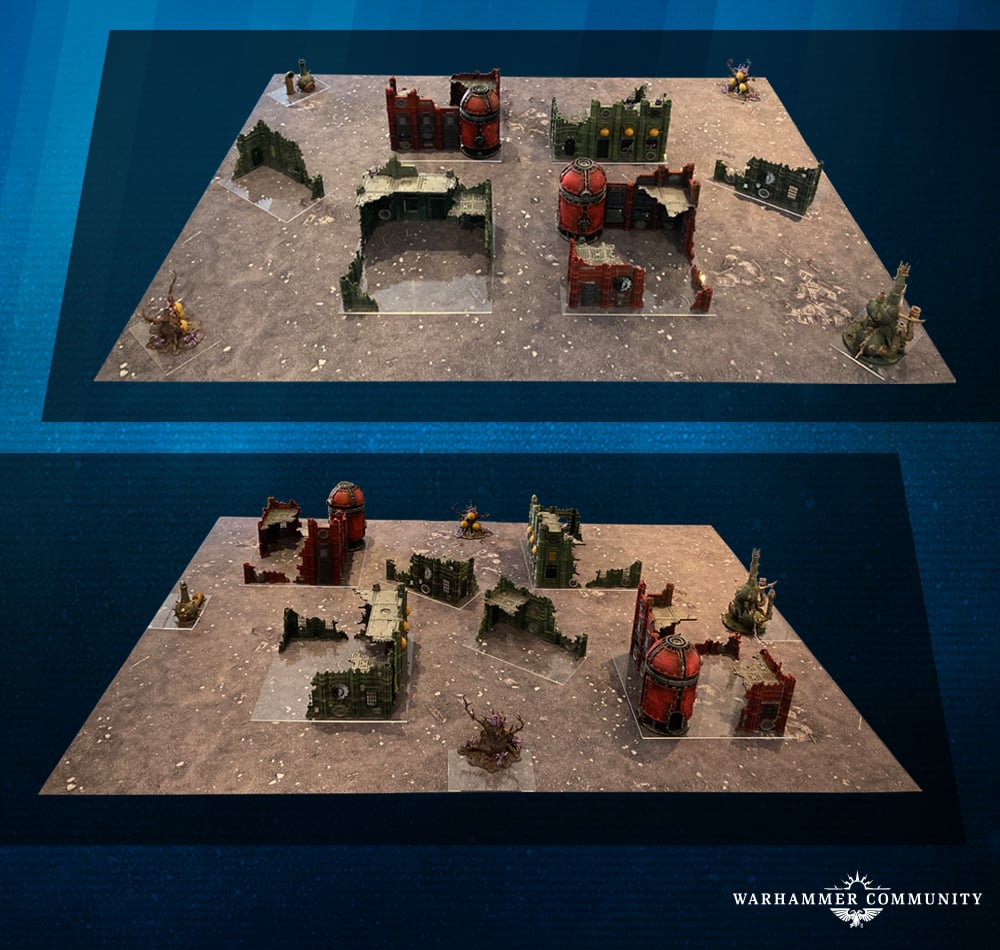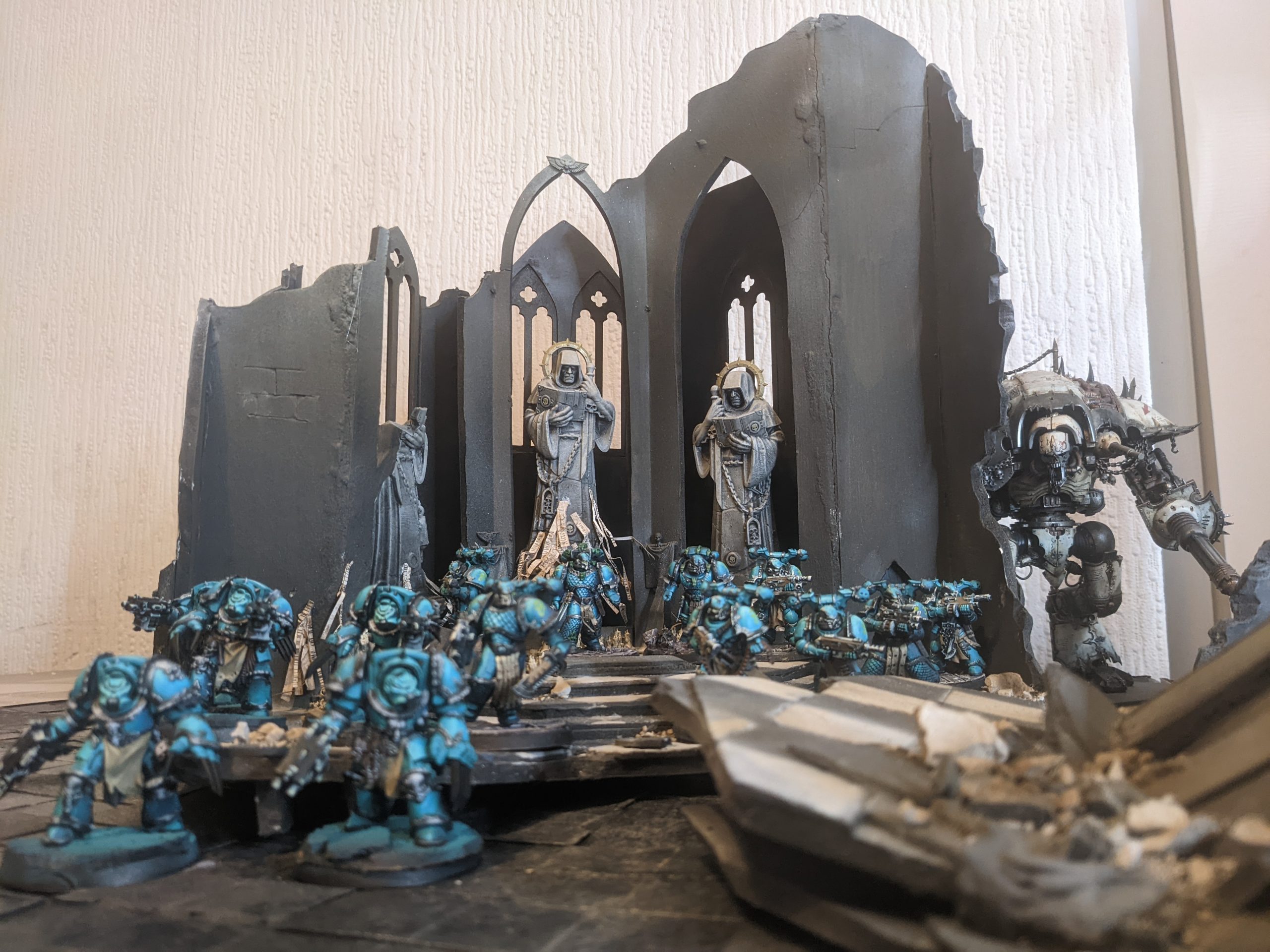40k City Fight Terrain
When you look at the Artwork for Warhammer 40k and compare it to the scenery that is sold by Games Workshop. You will tend to notice a huge difference in scale. Part of this is due to practically and partly its due to price. However its an iconic part of the Warhammer 40k setting. Fighting epic battles to the last man in the burned out ruins of a Temple, is a grimdark staple and the Plastic kits from games workshop don't really cut it.

What makes good terrain?
So what makes terrain fun to play on in a wargaming setting? Is it more important the terrain looks good or that it plays well? Is there a balance to be had? Theres also the issue of storage.
Aesthetics over functionality
If we were to ask a tournament player whats important to scenery, you might get the answer, fairness and functionality. Having clearly defined lines and practical scenery in a tournament setting makes sense. You're in a competitive environment.
- Being able to reach all your units is important, so the scenery is fairly low.
- You can't be nudging units around or dealing with wobbly model syndrome in a tournament. There is no "close enough", so it tends to be flat
- Defined boundaries, this is probably the most important for tournament play, you can't be second guessing if a mini is in or out of bounds of the terrain to count as in cover.

But the tables tend to look boring and generic. Very little in the way of scatter terrain and almost nothing that adds flavour to the board. This is GW's idea of a "beautiful" board.
Narrative players might say the opposite, willing to sacrifice practically for a bit more flair.
There are also people who are just happy to play with shoe boxes and cans of coke. These people are weirdos and should be avoided. I'm not criticising people who are just starting out or can't afford to spend a ton of money on scenery. You can create a pretty reasonable terrain board with a handful of cereal packets and a stick of glue and some cheap craft store paint and some imagination.
Storage
Theres also the practically of storage, will the table be static? You can create a great looking table that looks super realistic. However after 3-4 games it might feel a little samey. Statis tables are great for a club or event with loads of room where the table gets played once or can be rotated out between 3-4 other tables.
If the goal is modularity then being able to store the scenery becomes an issue, scenery is clunky and takes up the majority of our gaming space.
Is there a balance to be stuck between tournament and narrative scenery? Probably, but I definitely fall more into the narrative camp of scenery, willing to sacrifice a bit of gaming practicality for some aesthetic appeal. So my goal will be to create one or two centre pieces with scatter terrain that can all slot inside each other like russian dolls to take up minimal storage space.
What makes good 40k Scenery
40k is a great setting for wargaming, it is a vast universe that allows for almost any type of terrain you can think of. Even if you only have fantasy terrain, there are ways of making it work without breaking the setting. But the quintessential Warhammer 40k Scenery for me are the massive gothic cathedrals with steepled roofs, high arches and skulls and Aquila's plastering every window, keystone and pillar.
My ultimate gaming table is a massive table spanning cathedral with fallen pillars and collapsed statues scattered throughout.
The build
For speed of build and to keep the scenery lightweight, I opted to use foam-board as the base material.
I wanted at-least one large feature that gave the impression it had the scale of structures from the artwork of Warhammer 40,000 (even if such structures would be entirely impractical to game around). One corner of the structure would have to do with the majority of the height missing, but with some visual clues that it continues further.
All other structures would fit inside this large structure when packed away as to not take up any more additional room. Ultimately this actually allows it to store more neatly than other scenery I own which doesn't nest.
After loosely sketching out how I wanted the main feature (the ruined frontage of the cathedral) I traced it out 2 duplicate layers that, adjusted the window size to be slightly larger then the middle layer, when combined, would look like carved stone doorways and windows.
I then plaster the edges to hide the foam, add and some 3d printed skulls and a few bits from the bitz box to decorate.

The next piece would be smaller in all directions.




The next two pieces I forgot to document, but they both sit inside the medium piece. The tiles will be hobby foam (the kind they use in schools to make stuff out of), engraved with a pencil. Scattered debris is crushed plaster.


Painted up and heavily washed with enamel streak and grime to dull it down to neutral greys and browns. Our models will stand out better, and to give it the look of a battlefield thats been suitably war torn and battled over for 10,000 years.












